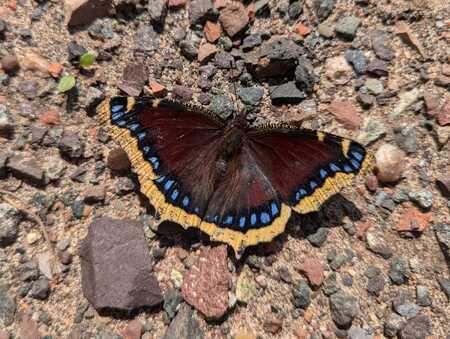
Good Natured: Mourning Cloak Butterfly
I bumped into an old friend the other day, in a most unexpected spot.
There I was pulled off on the side of M-64, a state highway in the western part of Michigan's Upper Peninsula, trying to figure out which waterfall the Furry Roommates and I should go see next, when I spotted him. Or maybe it was her.
Either way, I couldn't quite believe my eyes. Stranded there in the gravel was an individual I'd always considered a Late Winter/Early Spring Friend. Whenever we've met it's always been February, March or April. But this time it was nearly September.
To compound matters, my little buddy appeared to have been hit by a car. Not head on, because nothing was smashed and all the parts were there. But the blow was hard enough to have caused some disorientation; it also had made movement difficult.
So it was that I ended up spending quite a bit of time getting my friend to a more comfortable spot. Also, despite the car calamity—or perhaps because of it—I was also able to document our time together with pictures. Lots and lots of pictures!
This chance meeting with Nymphalis antiopa, the mourning cloak butterfly, got me thinking about their annual life cycle. I've always heard about them being one of our longest-lived butterflies, coming in 10 months to nearly a year. But if they really do persist that long, why is that we don't see them in summer—the time of year when most other butterfly species are at their peak?
The answer actually boils down to one word: estivation. Or, if you prefer the more traditional spelling, aestivation. Derived from the Latin words for residing during the summer heat, estivate means to slow down activity and metabolism during a hot and dry season. Here in the States, it's also sometimes referred to as summer dormancy.
Even though I can't remember whether I took a vitamin this morning, I can, for whatever reason, distinctly remember coming across this most interesting word back in 1969, the year my Grandpa Atterberry bought me a copy of Reptiles and Amphibians, A Guide to Familiar American Species (“212 species in full color." Oh boy!). There in the introduction to the Reptiles section the text states, “Desert reptiles avoid direct midday sun. Some become dormant (aestivate) in midsummer."
At the time I was certain that my life would eventually be filled with opportunities to observe animals that aestivate, or estivate, just like I was also pretty sure I would one day need to extricate myself from quicksand and escape the death grip of a man-eating clam. (Thanks Clutch Cargo!)
But here we are, 50-some odd years later, and other than a couple vocabulary tests in high school and college, I have yet to really use the word estivate. Or aestivate. Until now.
Right now, mourning cloak butterflies are out and about again, having spent much of the summer, yep, estivating. It seems the same adaptations that allow this species to flit about on warm winter days cause them to take it easy as we hit summer's peak.
The butterfly's common name alludes to one of these features. Dark in color, velvety in appearance, the mourning cloak does indeed resemble garments traditionally worn at funerals. Appropriate for grieving, such cloaks aren't the first choice for, say, a day at the beach or a 4th of July barbecue.
While a human could shed their cloak for such activities, a mourning cloak can't. But you know what it can do? Estivate. Or aestivate.
Another factor contributing to this butterfly's behavior is its preferred diet. Unlike many butterflies that thrive on the rich nectars of summer flowers, mourning cloaks prefer to take their nourishment from items like overripe fruit—a commodity that is much more abundant in late summer and fall. By taking a few months off, the mourning cloak can conserve its energy until its favored food sources are more readily available.
While there is evidence that some populations of mourning cloaks migrate, it seems that many living here in northern Illinois, as well as those in northern Michigan, will employ yet another adaptation to survive the coming cold weather: They hibernate.
As the thermometer drops, these hardy souls will concentrate those sugars in their diet to form glycerol, a sort of antifreeze that protects their tissues from destruction in the cold. Tucked away in a sheltered spot, mourning cloaks spend the winter in yet another suspended state. They emerge again, as we mentioned earlier, in late winter and early spring to lap sap from sapsucker holes and maple sugaring buckets, among other sources.
Mating occurs soon after this second emergence, and death follows shortly after. But just as one generation ends, another begins. The eggs that were deposited on one of a variety of host trees (cottonwood and poplar, hackberry, willow and elm, to name a few) soon hatch into wee caterpillars, which develop in a communal web. The larvae feed on newly open leaves and, sometimes, each other before leaving their group home to pupate and start their new lives as fully fledged adults that soon estivate. Or aestivate. And eventually, hibernate. And that, my friends, is just great!
Pam Otto is the outreach ambassador for the St. Charles Park District. She can be reached at potto@stcparks.org.

